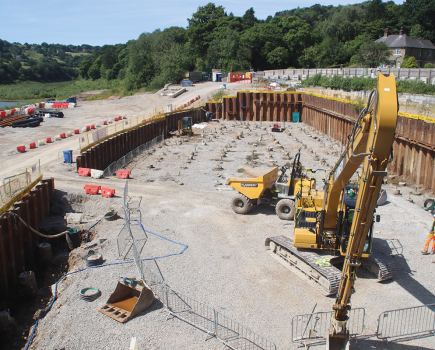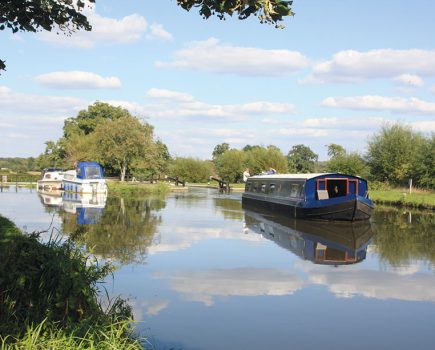The Thames, the Lee, the Grand Union and the Regent weren’t the capital’s only waterways. A team from the London Canal Museum has been tracking down the rest of the city’s canals…

The Thames through London is internationally famous; London’s ‘other’ waterways, the Regents Canal, the River Lee and the Grand Union Paddington Arm will be well-known to many Canal Boat readers and are increasingly familiar to the general public thanks to the likes of Camden Market; even East London’s Bow Back Rivers are emerging from obscurity thanks to the 2012 Olympics. But how many have heard of the capital’s other waterways? The Kensington Canal, the Fleet Canal, the Royal Arsenal Canal and numerous others, several of which you’d struggle to find any remains of today.
In a temporary exhibition running until the spring, the London Canal Museum has sought to throw some light on these little-known lost waterways. The Museum’s team has scoured London’s libraries, local museums and private collections, tracking down over 60 drawings, maps and other images from more than 30 sources, and researching the stories – why did these canals fail? Did they outlive their usefulness, or were they in some cases “frankly a complete waste of time” as one of the Museum team puts it? Each one tells a different story, and here are a selection…

Little-used survivors
A couple of ‘lost’ waterways aren’t actually abandoned – they’re tidal creeks which have lost the freight traffic which once sustained them, and are now are sought out only by intrepid boaters, and the occasional visit by a tideway cruise from St Pancras Cruising Club.
The Barking and Ilford Navigation, based on the River Roding, was once a busy waterway. Not only did it carry ‘night soil’ (sewage for fertiliser), chemicals, tar, and the products of breweries and tanneries (it’s no surprise that some of the locals complained about the smell!), it’s not widely known that it was home to the world’s largest fishing fleet in the 1850s, with many smaller craft employed to ferry the cargoes from the fishing vessels out at sea to the creek. Rail-served east coast ports put paid to this trade, and the commercial use of the waterway declined.

Likewise the Dartford & Crayford Navigation (based on two tidal creeks) carried 200,000 tons of trade annually to the local flour and gunpowder mills, but had lost its last traffic by the early 1980s when the lock which retained water at low tide was abandoned. Today there is a proposal to restore it.
Overtaken by events

The City Canal, sometimes called the Isle of Dogs Canal, cut across the top of the ‘Isle’ – a loop of the river between Blackwall and Limehouse. As the docks in the area expanded, the canal was incorporated into them and ceased to exist as a separate entity. Today the docks are no longer used commercially, and the loop in the river is the site of the Canary Wharf tower and other modern Dockland developments (and familiar to many TV viewers from the title sequence of EastEnders).
The one that got away

If the Grand Surrey Canal had lasted just a little longer, it might have still been with us today. As the name suggests, it was conceived as a rather more grandiose plan to serve several parts of the county – including Kingston, Mitcham and Epsom. All that was actually built was a four-mile canal from the Thames to Camberwell, and a half-mile arm to Peckham. But it performed a useful role carrying timber, effectively as an extension of the Surrey Docks, until both docks and canal closed around 1969. It was quickly filled in (there had been drownings, including children) and the Camberwell end formed the nucleus of the new Burgess Park. If the canal had somehow survived, might it have provided some much-needed mooring space in the capital today?
Over-optimistic ideas

Some canals simply didn’t live up to their promoters’ hopes. A good example is the Croydon Canal: conceived to connect Croydon to the Grand Surrey Canal (and so to the docks), it involved some heavy engineering with 28 locks in the first couple of miles as it climbed away from the Thames into what is now south London but, but was then open countryside. By the time the nine-mile canal was open in 1809 it had cost three times the original estimate, it carried disappointingly little cargo, and it sold out to a railway company who filled it in and used much of the canal bed for their route. Today, a canal reservoir survives as a boating lake, and two fragments of the actual canal survive in water, as a nature reserve and a long thin park pond.
The Fleet Canal, a conversion of the tidal length of the River Fleet, was another flop: not helped by Smithfield Market’s “dung, gut and blood” ending up in its waters, it was little used, and was covered over in the 1730s. And the Kensington Canal, another canalisation of a creek, was an abject failure. Tidal restrictions and silting added to its problems, and the upper sections disappeared under a railway by 1863 – although the lower end survived, and the final section forms a water feature in a new development today.
But if these seem to have been overoptimistic, they’re as nothing compared to the 1826 Grand Imperial Ship Canal, whose 130 miles of ship-sized canal would have linked London and Portsmouth; however it was abandoned before construction began, in spite of some money having been raised.
London Canal Museum
The London Canal Museum is situated on New Wharf Road, 5-10 minutes walk from King’s Cross and St Pancras stations, and backing on to Battlebridge Basin on the Regent’s Canal. It is open Tuesdays to Sundays from 10am to 4.30pm. The temporary exhibition London’s Lost Canals is on display until April 2018.
The museum is a converted Victorian ice house, with two huge ice wells under the building which in the days before refrigeration were used to store ice imported from Scandinavia for distribution around London. The museum therefore includes a display about the ice trade, alongside its exhibits dealing with London waterways, boats and cargoes, horseboating and more.
For more information contact 020 7713 0836 or see canalmuseum.org.uk.
Image(s) provided by:
London Canal Museum








